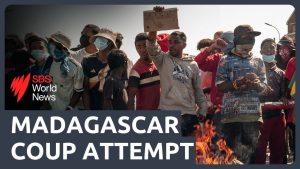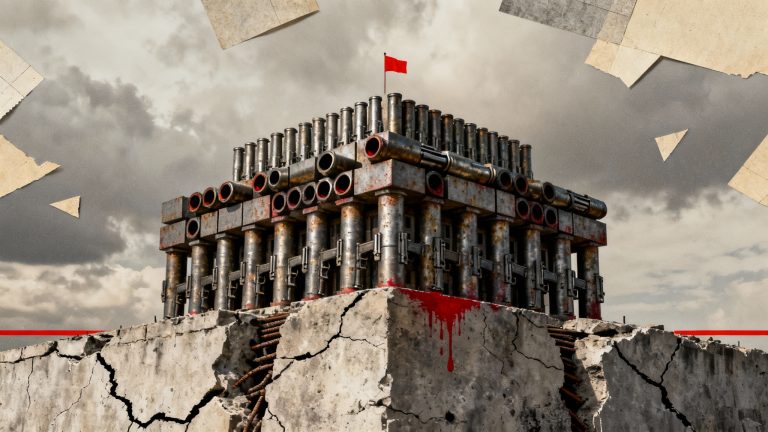
Current Situation: Bottom Line Up Front
 Madagascar is in the midst of a political crisis, as youth-led protests that began over chronic service delivery failures have escalated into a direct challenge to the rule of president Andry Rajoelina. The situation reached a critical inflection point with the intervention of an elite military unit, which has sided with the demonstrators. The crisis represents a dangerous standoff between a digitally organized new generation demanding systemic change and a political establishment steeped in a history of unconstitutional power transfers. With the defection of the very military unit that was instrumental in his own 2009 rise to power, Rajoelina’s political survival is in grave jeopardy, and the risk of an imminent coup d’état is extremely high.
Madagascar is in the midst of a political crisis, as youth-led protests that began over chronic service delivery failures have escalated into a direct challenge to the rule of president Andry Rajoelina. The situation reached a critical inflection point with the intervention of an elite military unit, which has sided with the demonstrators. The crisis represents a dangerous standoff between a digitally organized new generation demanding systemic change and a political establishment steeped in a history of unconstitutional power transfers. With the defection of the very military unit that was instrumental in his own 2009 rise to power, Rajoelina’s political survival is in grave jeopardy, and the risk of an imminent coup d’état is extremely high.
Context: Deep-Rooted Structural Drivers
The 2025 protests are not a spontaneous event but the culmination of decades of unresolved structural issues plaguing the Malagasy state. The widespread public anger channeled by the youth movement is fueled by a potent combination of chronic economic distress, a legacy of political instability, and pervasive governance failures. Understanding these deep-rooted economic, political, and social grievances is critical to assessing the current crisis and its potential trajectory.
Chronic Economic Hardship and Inequality
Madagascar remains one of the world’s poorest nations, a reality that forms the bedrock of popular discontent. The disconnect between the daily struggles of the populace and the perceived wealth of the political class has created a fertile ground for unrest.
- Poverty Rate: According to the World Bank, a staggering 75% of the country’s 30 million people lived below the poverty line in 2022.
- Service Delivery Failure: Basic infrastructure is critically lacking, with only about one-third of the population having access to electricity.
- Unemployment: The nation faces a severe employment crisis, with the unemployment level currently standing at 45%.
- Public Resentment: Public anger is intensified by the contrast between widespread hardship and the visible wealth of the political elite. President Rajoelina’s family has become a focal point of this resentment; his daughter Ilona Rajoelina is often seen wearing designer brands, while his son Arena Rajoelina reportedly attends the elite EHL Lausanne hospitality school, making the public’s grievances tangible.
Legacy of Political Instability

The nation’s political history since its 1960 independence has been characterized by fragility and punctuated by popular uprisings. This historical pattern provides the primary analytical lens through which to view the current crisis. Rajoelina himself first came to power in a military-backed coup in 2009, ousting then-president Marc Ravalomanana after a period of intense street protests. This precedent of unconstitutional power changes, facilitated by the same institutional actors involved today, has normalized the military’s role as the final arbiter in political disputes and frames the 2025 crisis as a direct and ironic repetition of the 2009 playbook.
Governance Failures and Systemic Corruption
Years of poor governance have eroded public trust in state institutions. In Transparency International’s 2024 Corruption Perceptions Index, Madagascar was ranked a lowly 140 out of 180 countries, indicating a deep-seated and systemic problem. For the protesters, the daily power and water outages are not merely technical failures; they are seen as emblematic of a corrupt and incompetent system that enriches a select few at the expense of the general population. These governance failures are at the core of the movement’s demands for a “radical change of the system.”
Immediate Triggers and Protest Dynamics
While structural grievances laid the groundwork for the crisis, a series of acute government failures in September 2025 served as the immediate catalyst. These triggers were harnessed by a new generation of activists who effectively channeled widespread discontent into a coherent and potent political movement.
Service Delivery Collapse as Catalyst

 The initial spark for the protests was the complete collapse of basic public services. Chronic, nationwide electricity and water shortages, known locally as délestage, intensified, with outages lasting up to 12 hours a day. Public frustration boiled over as the government proved incapable of providing these essential services while simultaneously investing in high-profile projects. A new $152 million cable car system in Antananarivo, in particular, became a potent symbol of the government’s misplaced priorities and its detachment from the fundamental needs of its citizens.
The initial spark for the protests was the complete collapse of basic public services. Chronic, nationwide electricity and water shortages, known locally as délestage, intensified, with outages lasting up to 12 hours a day. Public frustration boiled over as the government proved incapable of providing these essential services while simultaneously investing in high-profile projects. A new $152 million cable car system in Antananarivo, in particular, became a potent symbol of the government’s misplaced priorities and its detachment from the fundamental needs of its citizens.
The “Gen Z Madagascar” Movement
The subsequent demonstrations were defined by their unique character. The “Gen Z Madagascar” movement is a leaderless, youth-led phenomenon, primarily organized through social media platforms. It draws clear inspiration from similar “Gen Z” uprisings that have recently occurred in Indonesia and Nepal. The movement’s logo, a pirate skull and crossbones from the Japanese anime “One Piece,” modified with a traditional Malagasy satroka bucket hat, symbolizes a new generation’s rebellion against an authoritarian system. What began as a protest against power cuts rapidly expanded into a comprehensive call for political revolution.
The movement’s core demands include:
- The immediate resignation of President Andry Rajoelina.
- A complete dissolution of the government, parliament, and electoral commission.
- A radical overhaul of the political system to root out systemic corruption.
Key Actors and Their Positions
The crisis is currently defined by the actions and conflicting interests of three primary groups: the embattled presidency fighting for its survival, a determined youth movement refusing to compromise, and a critical segment of the military that has abandoned the government and sided with the people.
President Rajoelina
Rajoelina’s career has come full circle. Having risen from mayor of Antananarivo to national leader via the 2009 coup, he now faces a similar challenge from the streets. His response to the 2025 protests has been a series of escalating measures that have failed to quell the unrest. He first attempted to placate the demonstrators by dismissing his entire cabinet and appointing Army General Ruphin Fortunat Zafisambo as Prime Minister. When this failed, he offered a “national dialogue,” an overture that the protest movement publicly rejected. Finally, as the elite CAPSAT military unit openly joined the protesters, Rajoelina declared that an illegal, military-led power grab was underway, effectively acknowledging his loss of control over key state security elements.
The Gen Z Madagascar Movement
The Gen Z movement has proven to be a resilient and unyielding political force. Its members have systematically rejected all government concessions as insufficient and insincere, deriding the offer of talks as a “mockery.” The movement’s public statements reflect a deep-seated distrust of the current political establishment and a refusal to negotiate with what they see as an illegitimate regime.
“We reject this mockery of dialogue… We will not engage in dialogue with a regime that represses, assaults, and humiliates its youth.”
Their motivation is powerfully encapsulated in their slogan, which has resonated deeply with the nation’s youth: “We’re tired of just surviving, we want to live.”
The CAPSAT Military Unit
The decision by the elite Army Corps of Personnel and Administrative and Technical Services (CAPSAT) to side with the protesters is the most decisive development in the crisis. In a moment of profound irony, this is the very same unit that was instrumental in bringing Andry Rajoelina to power in the 2009 coup. In October 2025, CAPSAT soldiers openly refused orders to fire on protesters. They then left their barracks in armored vehicles, joined the demonstrations, and escorted thousands of civilians into central Antananarivo. In a direct challenge to the government’s authority, the unit subsequently announced that it was taking command of the army.
Timeline of Critical Events (September-October 2025)
The crisis has evolved with remarkable speed, escalating from localized service delivery protests to a full-blown national political emergency in a matter of weeks. The following timeline outlines the key events in this rapid deterioration.
- 25 September: Protests erupt in the capital, Antananarivo, over chronic water and electricity shortages. The demonstrations quickly spread to other cities. Security forces respond with force, and reports of looting and arson emerge.
- 29 September: After several days of escalating unrest, President Rajoelina dissolves the entire government and cabinet in an attempt to appease the demonstrators.
- Early October: Protests continue unabated. The UN Human Rights chief reports at least 22 people have been killed and over 100 injured, a figure the Malagasy government denies. The Gen Z movement rejects the government’s dismissal as insufficient and formalizes its demand for Rajoelina’s immediate resignation.
- 11 October: In a decisive turning point, soldiers from the elite CAPSAT unit mutiny. They leave their barracks in armored vehicles, escort protesters into the city center, and publicly announce their refusal of any orders to use force against civilians.
- 12 October: President Rajoelina releases a statement announcing that an “attempt to seize power illegally and by force” is underway, as the mutinous CAPSAT unit claims it is taking command of the Malagasy military.
Analysis: Risks and Strategic Implications
The crisis in Madagascar is not an isolated domestic event; it carries significant consequences that extend beyond its borders. The following section assesses the primary risks to national stability, democratic legitimacy, and regional security posed by the current standoff.
High Risk of Military Takeover
The immediate and most pressing risk is a full-scale coup d’état. The CAPSAT defection is not merely a mutiny but a signal that the foundational pillar of Rajoelina’s post-2009 power has collapsed, making a military takeover or a forced resignation a matter of high probability, not just risk. With the president’s own admission that a power grab is underway, the government’s control over the state’s security apparatus is critically compromised. The potential for violent clashes between military factions still loyal to the government and the mutinying units remains high, which could plunge the capital into a period of dangerous instability.
Erosion of Democratic Legitimacy
Regardless of the immediate outcome, the crisis is poised to inflict long-term damage on Madagascar’s political institutions. The events of 2025 reinforce a debilitating, decades-long cycle of unconstitutional power transfers, invalidating more than a decade of supposed democratic progress since the last unconstitutional takeover in 2009. This further erodes public trust in elections and democratic processes. Whether President Rajoelina is ultimately overthrown or manages to suppress the uprising with force, the outcome will likely deepen the country’s political fragility and make a return to stable, constitutional governance more difficult.
International and Regional Fallout
The international community is likely to react swiftly and negatively to a military takeover, drawing on the precedent set after the 2009 coup. A successful putsch would almost certainly trigger Madagascar’s immediate suspension from key regional bodies, including the African Union (AU) and the Southern African Development Community (SADC). Furthermore, it is highly probable that key international partners, including the United States and the European Union, would impose targeted sanctions and suspend all non-humanitarian aid. Such measures would severely exacerbate the ongoing economic crisis that underlies the current popular unrest.
Outlook
President Andry Rajoelina’s hold on power is extremely precarious. His political survival appears unlikely without a significant and improbable reversal of support within the armed forces. The situation remains highly volatile and unpredictable. The cohesion of the military, and whether other units follow CAPSAT’s lead, is the most critical variable. Simultaneously, the Gen Z movement’s ability to maintain popular pressure on the streets will be decisive. These two factors; the unity of the armed forces and the endurance of the protest movement, will determine Madagascar’s immediate future.

